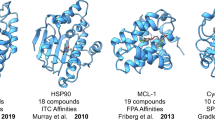Abstract
A key challenge in many drug discovery programs is to accurately assess the potential value of screening hits. This is particularly true in fragment-based drug design (FBDD), where the hits often bind relatively weakly, but are correspondingly small. Ligand efficiency (LE) considers both the potency and the size of the molecule, and enables us to estimate whether or not an initial hit is likely to be optimisable to a potent, druglike lead. While size is a key property that needs to be controlled in a small molecule drug, there are a number of additional properties that should also be considered. Lipophilicity is amongst the most important of these additional properties, and here we present a new efficiency index (LLEAT) that combines lipophilicity, size and potency. The index is intuitively defined, and has been designed to have the same target value and dynamic range as LE, making it easily interpretable by medicinal chemists. Monitoring both LE and LLEAT should help both in the selection of more promising fragment hits, and controlling molecular weight and lipophilicity during optimisation.


Similar content being viewed by others
References
Hopkins AL, Groom CR, Alex A (2004) Drug Discov Today 9:430–431
Kuntz ID, Chen K, Sharp KA, Kollman PA (1999) Proc Natl Acad Sci USA 96:9997–10002
Carr RA, Congreve M, Murray CW, Rees DC (2005) Drug Discov Today 10:987–992
Lipinski CA, Lombardo F, Dominy BW, Feeney PJ (1997) Adv Drug Deliv Rev 23:3–25
Reynolds CH, Bembenek SD, Tounge BA (2007) Bioorg Med Chem Lett 17:4258–4261
Reynolds CH, Tounge BA, Bembenek SD (2008) J Med Chem 51:2432–2438
Nissink JW (2009) J Chem Inf Model 49:1617–1622
Abad-Zapatero C, Metz JT (2005) Drug Discov Today 10:464–469
Hajduk PJ (2006) J Med Chem 49:6972–6976
Wenlock MC, Austin RP, Barton P, Davis AM, Leeson PD (2003) J Med Chem 46:1250–1256
Van de Waterbeemd H, Smith DA, Beaumont K, Walker DK (2001) J Med Chem 44:1313–1333
Leeson PD, Springthorpe B (2007) Nat Rev Drug Discov 6:881–890
Ryckmans T, Edwards MP, Horne VA, Correia AM, Owen DR, Thompson LR, Tran I, Tutt MF, Young T (2009) Bioorg Med Chem Lett 19:4406–4409
Keseru GM, Makara GM (2009) Nat RevDrug Discov 8:203–212
Verdonk ML, Rees DC (2008) Chem Med Chem 3:1179–1180
Watson P, Verdonk ML, Hartshorn MJ (2003) J Mol Graph Model 22:71–82
Acknowledgments
It is a pleasure to acknowledge helpful discussions with colleagues from the medicinal chemistry and computational chemistry groups at Astex, in particular David Rees, Marcel Verdonk and Gianni Chessari.
Author information
Authors and Affiliations
Corresponding author
Rights and permissions
About this article
Cite this article
Mortenson, P.N., Murray, C.W. Assessing the lipophilicity of fragments and early hits. J Comput Aided Mol Des 25, 663–667 (2011). https://doi.org/10.1007/s10822-011-9435-z
Received:
Accepted:
Published:
Issue Date:
DOI: https://doi.org/10.1007/s10822-011-9435-z



